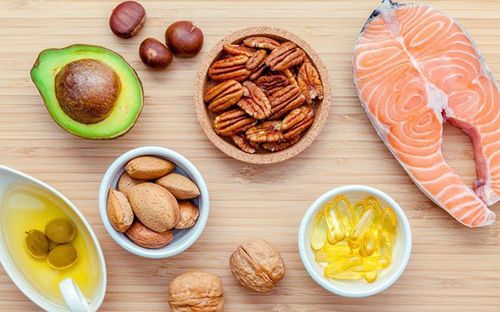Once infants reach 6 months of age and begin complementary feeding with solid foods, their meals should contain sufficient amounts of the four main nutrient groups. Therefore, parents can introduce omega-3 fatty acid supplementation from this age onwards.
1. Timing of Omega-3 oil supplementation in infants during complementary feeding
Omega-3 fatty acids are precursors to DHA, an important component for developing a child's brain, vision, and immune system. Therefore, omega-3 supplementation can offer several benefits, including:
- Elevates high-density lipoprotein (HDL) cholesterol levels while reducing blood fats and triglycerides;
- Improves visual acuity and protects ocular health in children;
- Enhances memory, promotes brain development, and improves attentional focus, leading to more effective learning;
- May mitigate symptoms of attention-deficit/hyperactivity disorder (ADHD) in some children.
In general, omega-3 fatty acids are highly beneficial for overall health; therefore, parents should ensure their children consume sufficient amounts of foods rich in these fatty acids to promote optimal growth and development.
When should Omega-3 oil be introduced to infants starting complementary feeding? For the first 6 months, infants mostly get their nutrition from breast milk, which already contains plenty of healthy fats. So, parents usually don't need to give their infants any extra oil during this time (unless there's a special reason).
When infants reach 6 months old and start eating solid foods like mashed fruits, soups, and porridge, their meals need to include all four important food groups (carbohydrates, fats, proteins, and vitamins and minerals). That's why cooking oil has become a regular part of their diet from this age.
When preparing food for children, it is essential to include oil in their porridge or powdered food. Fish oil and oils from seeds (like canola, soybean, sesame, and sunflower) are all high in Omega-3s. On the other hand, oils from fruits like palm, olive, and corn are high in Omega-6s (which help the body fight inflammation). Gac fruit oil is high in beta-carotene, which is turned into vitamin A and is good for eyesight. So, it's a good idea to switch between different oils to give your child a variety of nutrients.

2. What is the right amount of Omega-3 oil for infants during complementary feeding?
Using Omega-3 oil for infants starting solids is important, but many parents aren't sure how much to give. Generally, when introducing any nutritional oil to an infant's diet, it is advisable to start with a small amount and gradually increase it to assess tolerance, acceptance, and the infant's overall health status. For example, if your baby has diarrhea, you should reduce the amount of fat in their food.
Children under 2 years old require a substantial intake of nutrients and energy to support their rapid growth and development, including the maturation of various organs. During this period of significant physical development, characterized by a high growth velocity, parents need to ensure adequate fat intake in their child's diet. Depending on the child's age, preferences, and health status, this can constitute up to 30% of their daily caloric intake or even more.
At this age, the child's diet primarily consists of liquid foods (excluding fried or stir-fried dishes). Therefore, each bowl of porridge, soup, or powdered food needs approximately 10ml of cooking oil.
After the age of 2, children's growth rate gradually slows down. Most of them have all their teeth and can chew solid foods. They can eat a wider variety of foods and even share meals with adults (as long as the food is soft and cut into small pieces). This means the amount of Omega-3 oil they need can change depending on what they eat, what they like, and how they're feeling. For example, if parents notice their child is frequently lethargic, forgetful, difficulty concentrating, blurred vision, they may consider increasing the amount of Omega-3 oil in their child's daily diet.
Recommended daily intake of fats for children:
- Infants starting complementary feeding (under 6 months): Add 1/2 to 1 teaspoon of cooking oil (approximately 2.5 - 5ml) to their cereal, soup, or porridge.
- Children aged 1 to 2 years: Add 1.5 to 2 teaspoons (approximately 7 - 10ml) to their cereal, soup, or porridge.
- Children over 2 years old: Add 2 teaspoons of oil (10ml) to each meal or use for cooking.

3. Precautions for using Omega-3 oil in infants
When using nutritional oils to provide fats for infants, parents should pay attention to the variety of oils used and whether they contribute to the child's development. There are so many different baby oils out there, and each one has its benefits. Therefore, it is necessary to use them alternately and in a diversified manner to maximize their benefits. Don't just stick to one type of oil for too long, as this can mean your baby gets too much of some nutrients and not enough of others.
In addition, proper storage of cooking oil is also important. Cooking oils are generally sensitive to temperature, light, and oxygen. Therefore, children's cooking oil should be stored in a cool, dry, and well-ventilated place. The oil bottle should only be removed from storage for short periods when needed for use or cooking. Notably, vegetable oils such as coconut oil and palm oil, which contain high levels of saturated fatty acids, can be stored at room temperature.
Besides knowing when to choose the appropriate time to introduce cooking oil to infants, parents should also supplement essential micronutrients such as Zinc, Selenium, Chromium, Vitamins B1 and B6, Ginger, Acerola cherry extract (Vitamin C), etc. These can help your baby eat better, grow taller and stronger, and stay healthy so they don't get sick as often or have tummy troubles.
To arrange an appointment, please call HOTLINE or make your reservation directly HERE. You may also download the MyVinmec app to schedule appointments faster and manage your reservations more conveniently.








